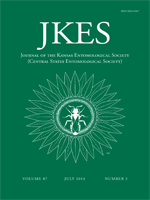Feeding bioassays were conducted to evaluate relative palatability of three different components of eastern redcedar (ERC) wood to the subterranean termite, Reticulitermes flavipes Kollar. Sections of fresh-cut ERC trunk were separated into three component groups: heartwood, sapwood, and ‘transition wood’ (sapwood-heartwood interface). Wooden blocks cut from these groups, as well as pine sapwood (control), were used in ‘choice’ and ‘no-choice’ bioassays. Half of each group was oven-dried while the other half was air-dried. In choice bioassays, pine sustained significantly greater weight loss compared with the air-dried ERC groups. Weight loss for air-dried ERC sapwood was significantly greater compared with both air-dried heartwood and transition wood. In no-choice bioassays, air-dried sapwood and pine sustained the greatest weight losses. Termite worker survival on pine (86.6 ± 2.6%) was significantly greater compared with both oven-dried sapwood (73.2 ± 4.2%) and air-dried sapwood (70.9 ± 3.2%), which were significantly greater than oven-dried transition wood (53.3 ± 4.2) and oven-dried heartwood (38.6 ± 6.5%). Overall, both oven-dried and air-dried heartwood were least palatable to termites.
BioOne.org will be down briefly for maintenance on 17 December 2024 between 18:00-22:00 Pacific Time US. We apologize for any inconvenience.
How to translate text using browser tools
1 July 2014
Palatability of Field-Collected Eastern Redcedar, Juniperus virginiana L., Components to Subterranean Termites (Isoptera: Rhinotermitidae)
C. E. Konemann,
B. M. Kard,
M. E. Payton
ACCESS THE FULL ARTICLE
Eastern redcedar
Juniperus virginiana
Reticulitermes flavipes
termites





